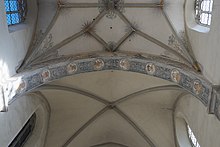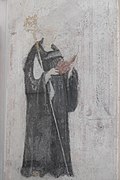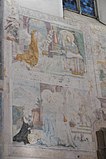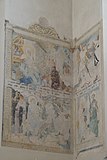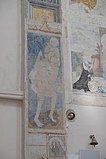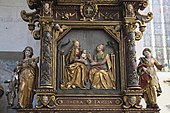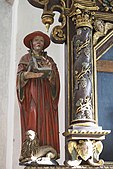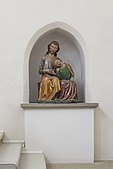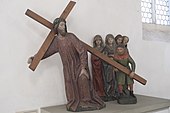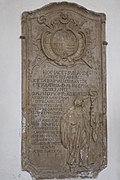St. Anna (Heiligkreuztal)
The Catholic parish church of St. Anna in Heiligkreuztal , a district of the Altheim community in the Biberach district in Baden-Württemberg , was built at the beginning of the 14th century as the monastery church of the Cistercian monastery Heiligkreuztal . The church, which has also been open to lay people since 1699, was elevated to a parish church in 1843 and belongs to the Biberach deanery of the Rottenburg-Stuttgart diocese . The church has preserved valuable pieces of equipment, a large stained glass window from the early 14th century and frescoes from the Gothic and Renaissance periods .
history
In the place known as Wazzershaf , Beguines formed a community in 1227 , which in 1233 submitted to the Cistercian order. In 1256 the monastery buildings were consecrated. The later Brother Church, which was originally consecrated to Mary and the Holy Cross and which is now a museum , probably served as the first church . Before 1315 the foundation stone for the later monastery and today's parish church was laid by a builder named Konrad. This church, a three-aisled , flat-roofed pillar basilica with three altars and a large east window, was consecrated on May 20, 1319 to the Evangelist John . Between 1520 and 1533, the abbess Veronika von Rietheim , who headed the monastery from 1520 to 1551, had the side aisles and the main nave vaulted and the nuns' choir expanded. Abbess Anna Stebenhaber, who ran the monastery from 1602 to 1616, had the church repainted and given new furnishings in the style of the early Baroque . In 1699 the church was opened to laypeople and an outside portal on the west facade of the north aisle was broken through. In 1843 the former monastery church was elevated to a Catholic parish church with the patronage of St. Anne , and the women's choir was assigned to the Protestant community as a prayer room.
architecture
Exterior construction
The high from a gable roof covered the central nave is of a pointed roof turret crowned. The much lower aisles are covered with pent roofs. The coats of arms of the monastery, the Cistercian order and the abbess Maria Anna von Holzing are carved over the portal, which was built towards the end of the 17th century . On the west gable sits a wrought iron, late baroque weather bell from 1770.
inner space
The three-aisled nave is high, resting on pillars pointed arch arcades divided. The main and side aisles are covered by late Gothic rib vaults with carved keystones . In clerestory three-lane are tracery windows cut. The choir , to which a pointed choir arch leads, is just closed, as is customary in Cistercian churches. The western end of the nave is formed by the nun's gallery , which protrudes far into the nave , the parapet of which is decorated with the coats of arms of the Cistercian order and the abbess Veronika von Rietheim.
Frescoes
The ceiling and wall paintings were partially exposed again in 1898. The oldest frescoes were probably made between 1312 and 1319, such as the head of Christ with a nimbus on the east wall of the north aisle, which was exposed in 1955 . The depictions of the two patrons of the order, St. Benedict of Nursia and St. Bernard of Clairvaux, as well as the depiction of St. Dorothea on the central pillar of the north aisle also date from the early 14th century . The Deësis motif on the southern wall of the nave is dated to the same time , in the middle of which Christ is enthroned as judge of the world, while Mary and John the Baptist intercede.
Most of the wall paintings date from the first half of the 16th century. They are ascribed to the master von Meßkirch and were commissioned by the abbess Veronika von Rietheim. A Madonna and Child and St. Bernard of Clairvaux are depicted on two pillars. On the wall above the choir arch you can see Mary, crowned by angels, below the abbess Veronika von Rietheim with her coat of arms and a banner with the inscription “O mater Dei, memento mei” (O Mother of God, remember me). The reveal of the choir arch is decorated with medallions depicting prophets and, at the bottom left, St. Christopher and St. Barbara at the bottom right .
The heavily faded fresco cycle in the choir was created after 1531. On the left wall of the choir, the Annunciation can be seen in the upper scene and the Visitation in the lower scene . Other scenes include the adoration of the Magi , the killing of the innocent children and the flight into Egypt . The frescoes on the south wall of the choir are dedicated to saints such as St. Cyril and the martyrdom of St. Sebastian .
Choir window
The large stained glass window in the choir was commissioned by Abbess Elisabeth von Stoffeln in 1312 and was probably made in a glass painting workshop in Constance. The four-lane tracery window was damaged by hail in the 19th century, and individual panes were replaced. In addition to a Madonna and Child, the beheading of the Apostle Paul and the crucifixion of the Apostle Peter, numerous saints and martyrs are depicted on the window .
Altars
- The rosary altar is a work from 1619. On the altarpiece by Johann de Pay the Elder, Mary with the baby Jesus is surrounded by round medallions on which the secrets of the rosary can be seen. At her side are St. Bernard of Clairvaux and St. Dominic . In the center of the predella you can see the praying abbess Katharina von Roggweil, on the left the apostle James the Elder and on the right St. Christopher. The assistant figures , the apostles Peter and Paul, were carved by Melchior Binder.
- The Lactatio altar from 1608 is also by Melchior Binder. The altar is dedicated to the Lactatio of St. Bernard of Clairvaux, co-founder of the Cistercian order. Bernhard kneels in front of Maria, who holds out her bare chest to him. The figures on the side are Saint Agnes , at whose feet a lamb crouches, and Saint Thekla with a lion at her feet. The coronation of Mary is shown in the altar extract .
- The altar, entitled Sacra Familia , contains a late Gothic Madonna and Child from around 1515, which comes from an Ulm workshop. Saint Anne seated opposite Mary is dated around 1600. It is a work by Melchior Binder, who also created the side figures, an instruction of Mary on the left and the figure of Mary on the right. In the altar extract you can see a child with a guardian angel.
- The Pietà altar from 1671 frames an early baroque Vespers picture from around 1600. Maria sits at the foot of the cross, her face contorted with pain, her heart being pierced by a sword. Her son's corpse lies on her lap, and a praying angel looks up at him. On the side of the altar are the church father Jerome on the left and Saint Nicholas on the right with a book on which there are three golden balls. The two carved figures are dated around 1500. The altar is crowned by two angels with instruments of passion and a picture of St. Veronica, who is holding the handkerchief of Jesus .
- The Dreikönigs-Altar contains a late Gothic panel painting depicting the Adoration of the Magi from around 1450 by the painter Martin Schaffner , who belongs to the Ulm School . The half-figures on the predella, the four evangelists with their symbols, were added in the 18th century.
- A relief depicting Jesus and the sleeping disciples on the Mount of Olives is integrated in another altar. At the top right edge you can see an angel holding a chalice and the cross in his hands.
Further equipment
- In a niche in the east wall of the choir stands a Christ-Johannes group (Johannesminne), which was probably created around 1318 in a workshop in the vicinity of the master Heinrich von Konstanz . It is carved from walnut wood and still preserved in its original version.
- A sacrament house from 1424, decorated with pinnacles and eyelashes , is walled into the north wall of the choir . On the relief above the doors the four evangelists are depicted with their symbols , on the side Mary and Jesus as the Man of Sorrows .
- The group carrying the cross from around 1450 is the work of the Ulm sculptor Hans Multscher and his workshop.
Tombstones
The gravestones of the abbesses Maria Anna von Holzing († 1722) and Anna Maria Josepha von Holzapfel, who worked as abbess from 1723 to 1761, are walled up in the walls of the aisles.
literature
- Otto Beck, Carla Fandrey: Heiligkreuztal. A companion through the cathedral and monastery complex . Beuroner Kunstverlag Josef Fink, Beuron 2004, ISBN 3-89870-166-2 .
Web links
- Heiligkreuztal LEO-BW
Coordinates: 48 ° 8 ′ 10 " N , 9 ° 24 ′ 13.3" E








